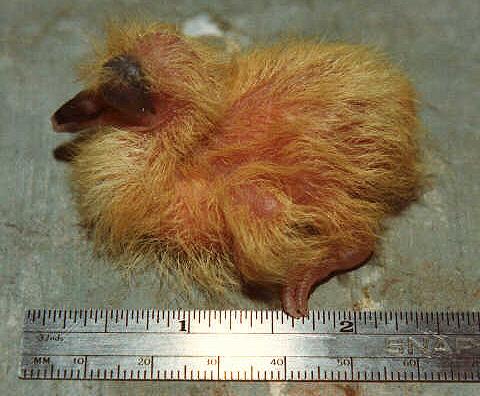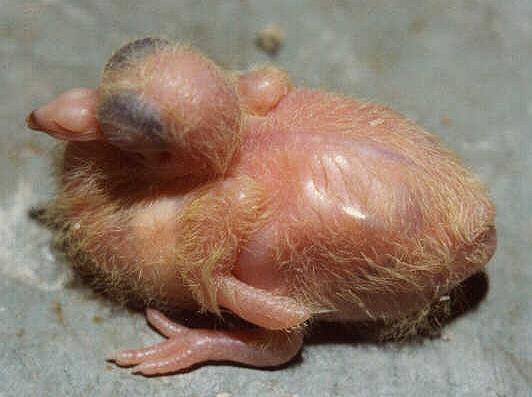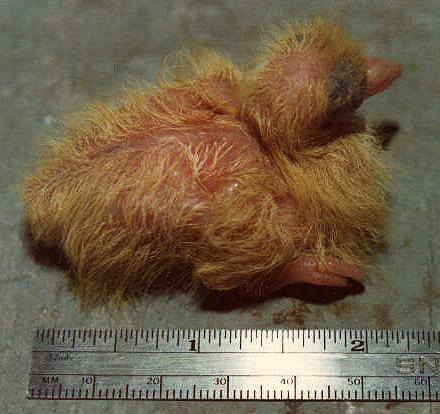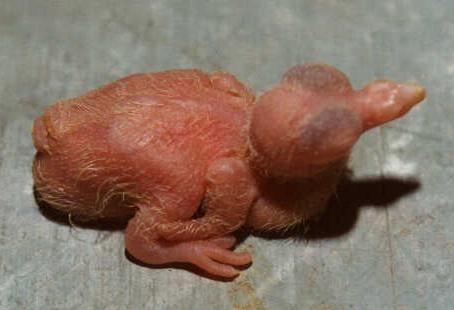pigeons
Looking At 'BABY PIGEONS' For Information!
By Robert J. Mangile
American Pigeon Journal
January 1990, pages 20 & 21.
The importance of an established genetic Standard can be keenly appreciated when we try to understand the relationship between the outward appearance (or phenotype) of a newly hatched squab and its eventual appearance as an adult pigeon. Many variables interfere with the understanding of this relationship.
It is important to keep in mind that in the effort to establish a few
basic guidelines, with respect to natal down and pigmentation; falling into
error is almost inevitable. With that thought foremost in mind, we might
give consideration to the features of a squabs down and areas of
pigmentation; as they relate to their adult appearance (or phenotype).
Owing to the great diversity in domestic pigeons we are driven to seek out a
stable set of characteristics as a starting point. Even though wildtype may
vary with geographical location, that seems to be our best alternative. The
Rock Pigeon
(Columba livia), has long been the Standard
of comparison for variations in domestic pigeons. Therefore, using the down
length and pigmentation of newly hatched squabs of the wild Rock Pigeons as
our Standard seems appropriate.
In "wildtype" squabs, the down length should be considered neither long nor
short; but instead..., as wildtype down. Experience has led me to suspect
that grizzle produces longer than normal down in some squabs and that
Chinese Owls often produce squabs with shorter than normal down. These
observations may be incorrect if down lengths are actually measured? Until a
precise way of determining down length is established we are forced to
resort to our visual assessments.
On page 40 of Dr. W. F. Hollanders book; entitled,
"Origins and Excursions in Pigeon Genetics", he states: "At first the
dilution factor was considered the only cause of the short-down condition,
but as other color factors were studied it became clear that 'd' had no
monopoly. Short down is typical in squabs of the almond, homozygous faded,
faded brown, albino, pink-eyed dilute, and perhaps some other color classes.
White and albino ringneck doves are similarly short-downed. Also
lethal-polydactyl (py) and homozygous silky squabs are short-downed,...".
The skin, bill and foot coloration of Rock Pigeons also has a marked
description; which should also be referred to as wildtype. In describing
bill coloration of wild pigeon hatchlings, Derek Goodwin states, on page 45,
of "Pigeons and Doves of the World", as follows:
"Newly-hatched nestlings of all species that I have seen (or have seen
descriptions of) have, however, a very similarly coloured bill with a very
pale tip, then a blackish band."
Among domestic pigeons, blue plumage tends to range in either direction from the accepted wildtype; i.e., some are very dark or "dirty" blue and others are very light or "icy" blue. These variations in adult plumage may be detected in the pigmentation of a hatchlings bill and/or feet. Squabs with blackened bills and feet always have dirty plumage and those with flesh colored bills and feet are always very light or icy blue. The bill ring is present in both types but in extremely dirty birds their entire bills (and feet) may be solid black; thereby, making the bill ring difficult to distinguish. [See photos below.] This type of pigment diffusion can often be detected in browns, ash-reds and other mutant types. As a general rule the darker the bill, the darker the feet (but not always).
Some mutant types such as brown and recessive red have a reddish bill ring on a light bill. Ash-reds often have a horn or brownish-black bill pigmentation. Brander bronze or kite display blackish-chocolate coloration on their bills and feet. Recessive white and reduced squabs completely lack a bill ring and display a pale-flesh bill and feet. Almond and faded squabs may or may not have totally pale-flesh bills depending on the birds genetic makeup (genotype) and sometimes appear similar to albinos.
Albinos and pink-eyed dilutes are almost entirely pinkish, rather than
pale-flesh in appearance; they lack bill rings, are extremely short downed
and have pink eyes beneath the eyelids. Various pied varieties and birds
from pied stock may appear mostly normal but often display light toenails or
blotched feet and/or bill.
Many pages can be written in an attempt to clarify the relationship between the phenotype of a new hatchling and its eventual adult phenotype. Too many genetic combinations alter the outward appearance of a squab (or adult) to make classification simple. However, it seems that there is much to be shared among pigeon fanciers on this matter. Study should not be limited to down length or bill color but should include every visible characteristic of the new hatchling. For example; erratic squabs roll their necks during the first few days of life and porcupine squabs have roughened, crusty appearance when hatched. Just how much knowledge can be gathered is anyone's guess. Hopefully this might spawn an interest in this area of general ignorance!
Figure 1.
A normal downed, dirty-blue, t-pattern Parlor
Tumbler squab. Notice the diffusion of black pigment on the bill which
incorporates the black bill ring at tip of bill. The feet are somewhat
lighter than expected in this specimen.
(Photo by Kerry Hendricks)

Figure 2.
A short downed,
dilute-blue, t-pattern Parlor Tumbler hen. Notice the pale-flesh bill and
feet and a slightly brownish, rather than blackish, bill ring at tip of
bill. Also, the eyes beneath the eyelids are dark.
(Photo by Kerry Hendricks)

Figure 3.
A reduced-blue, t-pattern spread Parlor Tumbler
hen. Notice a totally pale-flesh bill and feet and the down does not appear
to be shorter than normal. Eyes are dark beneath the eyelids.
(Photo by Kerry Hendricks)

Figure 4.
An almond-blue, t-pattern Parlor Tumbler
hen. Notice the entire pinkish-flesh appearance; including the bill, skin
and feet. The down is extremely short and the
eyes rather pinkish beneath the eyelids. Albino and pink-eyed dilute squabs
are very similar.
(Photo by Kerry Hendricks)
